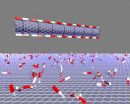(Press-News.org) BOSTON – January 23, 2011 – Strokes are a leading cause of mortality and adult disability. Those that involve intracerebral hemorrhage (bleeding in the brain) are especially deadly, and there are no effective treatments to control such bleeding. Moreover, diabetes and hyperglycemia (high blood glucose levels) are associated with increases in bleeding during hemorrhagic stroke and worse clinical outcomes.
But Joslin Diabetes Center researchers now have identified one key player that contributes to this increased bleeding, a discovery that may pave the way toward treatments that minimize adverse stroke outcomes both for people with pre-existing diabetes and those with hyperglycemia identified at the time of stroke.
Studies in the lab of Joslin Investigator Edward Feener, Ph.D., pinpointed a new mechanism involving a protein called plasma kallikrein that interferes with the normal clotting process in the brain following blood vessel injury with diabetes. Their work is reported online in the journal Nature Medicine.
The scientists began by injecting a small amount of blood into the brains of rats with diabetes and of control animals without diabetes. The difference was dramatic—the diabetic animals bled over a much greater area of the brain.
Work in the Feener lab had previously implicated plasma kallikrein in diabetic eye complications. When the experimenters pre-treated the diabetic animals with a molecule that inhibits the protein's effects, brain damage from the blood injections dropped to levels similar to that in the control animals. Conversely, when pure plasma kallikrein was injected into the brain, it produced little impact on the control animals but rapidly increased major bleeding in the animals with diabetes.
Further studies by the Joslin researchers showed that normalizing blood glucose levels in diabetic animals could block the effect from plasma kallikrein, and that rapidly inducing hyperglycemia in control animals mimicked the effects of diabetes on brain hemorrhage. This suggests that high blood sugar at the time of brain hemorrhage, rather than diabetes per se, is responsible for the increased bleeding.
"Given the prevalence of strokes and the damage they inflict, these findings are exciting because they suggest the possibility that rapid control of blood sugar levels may provide an opportunity to reduce intracerebral hemorrhage, which is a clinical situation that has very limited treatment options," says Dr. Feener, who is also an associate professor of medicine at Harvard Medical School. "This work could have broad implications since about half of patients with acute hemorrhagic stroke have hyperglycemia, whether or not they have pre-existing diabetes."
The work also raises the possibility of developing drugs that target plasma kallikrein and may provide protective measures in people with diabetes or others at high risk for stroke. Such drugs might also prove useful for patients suffering from the more common ischemic strokes, which usually begin as blocked vessels in the brain but can transform into hemorrhages.
Surprisingly, while plasma kallikrein has been studied for decades, the Joslin scientists found that the protein boosts brain bleeding through a previously unknown mechanism—by blocking platelet activation near damaged blood vessels.
###
Joslin's Jia Liu and Ben-Bo Gao were co-lead authors on the Nature Medicine paper. Other contributors include Joslin's Allen Clermont, and Price Blair and Robert Flaumenhaft of Beth Israel Deaconess Medical Center, and Tamie Chilcote and Sukanto Sinha of ActiveSite Pharmaceuticals. Lead funding came from the National Institutes of Health and the American Heart Association.
Culprit found for increased stroke injury with diabetes
Finding may lead the way toward treatments that minimize adverse outcomes
2011-01-24
ELSE PRESS RELEASES FROM THIS DATE:
Curved carbon for electronics of the future
2011-01-24
A new scientific discovery could have profound implications for nanoelectronic components. Researchers from the Nano-Science Center at the Niels Bohr Institute, University of Copenhagen, in collaboration with Japanese researchers, have shown how electrons on thin tubes of graphite exhibit a unique interaction between their motion and their attached magnetic field – the so-called spin. The discovery paves the way for unprecedented control over the spin of electrons and may have a big impact on applications for spin-based nanoelectronics. The results have been published in ...
Nailing down a crucial plant signaling system
2011-01-24
Stanford, CA— Plant biologists have discovered the last major element of the series of chemical signals that one class of plant hormones, called brassinosteroids, send from a protein on the surface of a plant cell to the cell's nucleus. Although many steps of the pathway were already known, new research from a team including Carnegie's Ying Sun and Zhiyong Wang fills in a missing gap about the mechanism through which brassinosteroids cause plant genes to be expressed. Their research, which will be published online by Nature Cell Biology on January 23, has implications for ...
Fighting the fight for healthy teeth
2011-01-24
It is known that teeth can protect themselves, to some extent, from attack by bacteria but that inflammation within a tooth can be damaging and, in extreme cases, lead to abscess or death of the tooth. New research published in BioMed Central's open access journal BMC Immunology shows that odontoblast cells are part of the immune system and fight to protect teeth from decay.
Inside a tooth odontoblast cells sit between the enamel and pulp and produce a layer of dentin to protect the pulp from wear and infection. This research shows that, when under attack from bacteria, ...
Genetic sequencing alone doesn't offer a true picture of human disease
2011-01-24
DURHAM, N.C. – Despite what you might have heard, genetic sequencing alone is not enough to understand human disease. Researchers at Duke University Medical Center have shown that functional tests are absolutely necessary to understand the biological relevance of the results of sequencing studies as they relate to disease, using a suite of diseases known as the ciliopathies which can cause patients to have many different traits.
"Right now the paradigm is to sequence a number of patients and see what may be there in terms of variants," said Nicholas Katsanis, Ph.D. "The ...
Researchers find smoking gun of world's biggest extinction
2011-01-24
About 250 million years about 95 per cent of life was wiped out in the sea and 70 per cent on land. Researchers at the University of Calgary believe they have discovered evidence to support massive volcanic eruptions burnt significant volumes of coal, producing ash clouds that had broad impact on global oceans.
"This could literally be the smoking gun that explains the latest Permian extinction," says Dr. Steve Grasby, adjunct professor in the University of Calgary's Department of Geoscience and research scientist at Natural Resources Canada.
Grasby and colleagues ...
More research needed on diet and environmental influences on childhood asthma
2011-01-24
St. Louis, MO, January 24, 2011 – Asthma is one of the world's most common chronic diseases, affecting as many as 300 million people. It is estimated that by 2025 there could be an additional 100 million people with the disease. This rapid increase in asthma is most likely due to changing environmental or lifestyle factors, and over the last 15 years, changing diet has emerged as a promising contributor. Two studies published in the in the February 2011 issue of the Journal of the American Dietetic Association explore the possible relationship between nutrition and asthma. ...
Anti-estrogen medication reduces risk of dying from lung cancer
2011-01-24
A new study has found that tamoxifen, an anti-estrogen breast cancer medication, may reduce an individual's risk of death from lung cancer. Published early online in Cancer, a peer-reviewed journal of the American Cancer Society, the study supports the hypothesis that there is a hormonal influence on lung cancer and that estrogen levels play a role in lung cancer patients' prognosis.
Previous research suggests that menopausal hormone therapy increases women's risk of dying from lung cancer. If this is true, the use of anti-estrogens should have the opposite effect. Elisabetta ...
IU study: Humans' critical ability to throw long distances aided by an illusion
2011-01-24
BLOOMINGTON, Ind. -- Can't help molding some snow into a ball and hurling it or tossing a stone as far into a lake as you can? New research from Indiana University and the University of Wyoming shows how humans, unlike any other species on Earth, readily learn to throw long distances. This research also suggests that this unique evolutionary trait is entangled with language development in a way critical to our very existence.
The study, appearing online Jan. 14 in the journal "Evolution and Human Behavior," suggests that the well-established size-weight illusion, where ...
Oniqua Enterprise Analytics Opens New Office in Africa
2011-01-24
Oniqua Enterprise Analytics, the leading provider of MRO analytics software solutions for asset-intensive organizations, today announced the establishment of a new office in Africa. Located in Sandton, Johannesburg, the new operations will service South Africa and the entire sub-Saharan African region.
Neil Pollock, a long-time business associate and partner of Oniqua, has been appointed Vice President and will head up the new operations.
"This expansion into Africa comes on the heels of the completion of the regional rollout of BHP Billiton's global implementation ...
New Video Resume Tool from TalentRooster Empowers Companies to See and Hear Candidates BEFORE the Interview
2011-01-24
TalentRooster (www.talentrooster.com), the world's leading video resume service today announced the release of a new record-from-home video resume tool. This new technology enables hiring managers to send a link to job candidates, providing them with an easy do-it-yourself tool to create a professional video resume from home. Hiring managers can select questions relevant to the position, which the candidate then answers in a video. There are written questions as well, should the hiring manager desire to include them.
TalentRooster CEO and President David DeCapua says ...
LAST 30 PRESS RELEASES:
Statins significantly reduce mortality risk for adults with diabetes, regardless of cardiovascular risk
Brain immune cells may drive more damage in females than males with Alzheimer’s
Evidence-based recommendations empower clinicians to manage epilepsy in pregnancy
Fungus turns bark beetles’ defenses against them
There are new antivirals being tested for herpesviruses. Scientists now know how they work
CDI scientist, colleagues author review of global burden of fungus Candida auris
How does stroke influence speech comprehension?
B cells transiently unlock their plasticity, risking lymphoma development
Advanced AI dodel predicts spoken language outcomes in deaf children after cochlear implants
Multimodal imaging-based cerebral blood flow prediction model development in simulated microgravity
Accelerated streaming subgraph matching framework is faster, more robust, and scalable
Gestational diabetes rose every year in the US since 2016
OHSU researchers find breast cancer drug boosts leukemia treatment
Fear and medical misinformation regarding risk of progression or recurrence among patients with breast cancer
Glucagonlike peptide-1 receptor agonists and asthma risk in adolescents with obesity
Reviving dormant immunity: Millimeter waves reprogram the immunosuppressive microenvironment to potentiate immunotherapy without obvious side effects
Safety decision-making for autonomous vehicles integrating passenger physiological states by fNIRS
Fires could emit more air pollution than previously estimated
A new way to map how cells choose their fate
Numbers in our sights affect how we perceive space
SIMJ announces global collaborative book project in commemoration of its 75th anniversary
Air pollution exposure and birth weight
Obstructive sleep apnea risk and mental health conditions among older adults
How talking slows eye movements behind the wheel
The Ceramic Society of Japan’s Oxoate Ceramics Research Association launches new international book project
Heart-brain connection: international study reveals the role of the vagus nerve in keeping the heart young
Researchers identify Rb1 as a predictive biomarker for a new therapeutic strategy in some breast cancers
Survey reveals ethical gaps slowing AI adoption in pediatric surgery
Stimulant ADHD medications work differently than thought
AI overestimates how smart people are, according to HSE economists
[Press-News.org] Culprit found for increased stroke injury with diabetesFinding may lead the way toward treatments that minimize adverse outcomes


